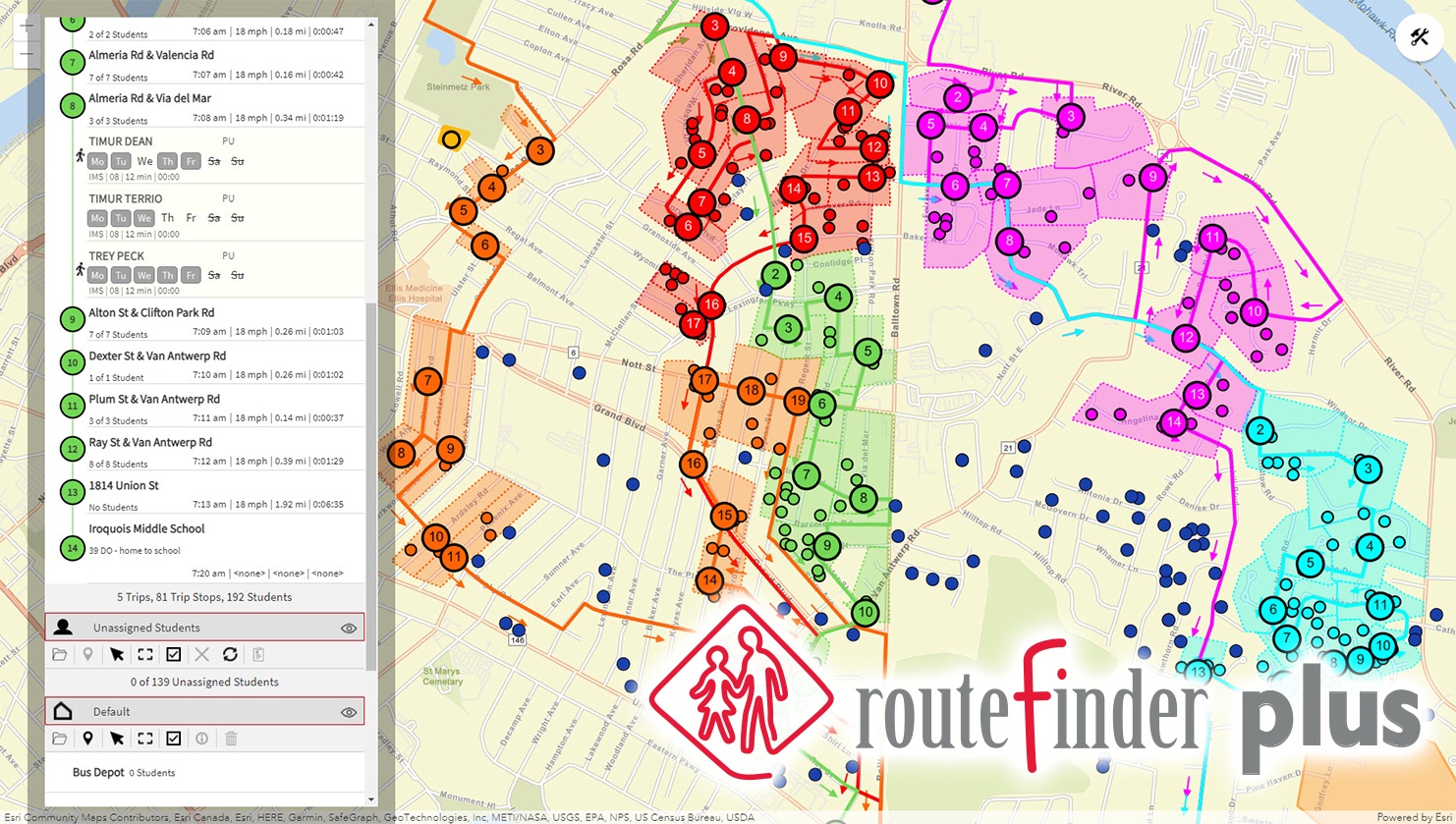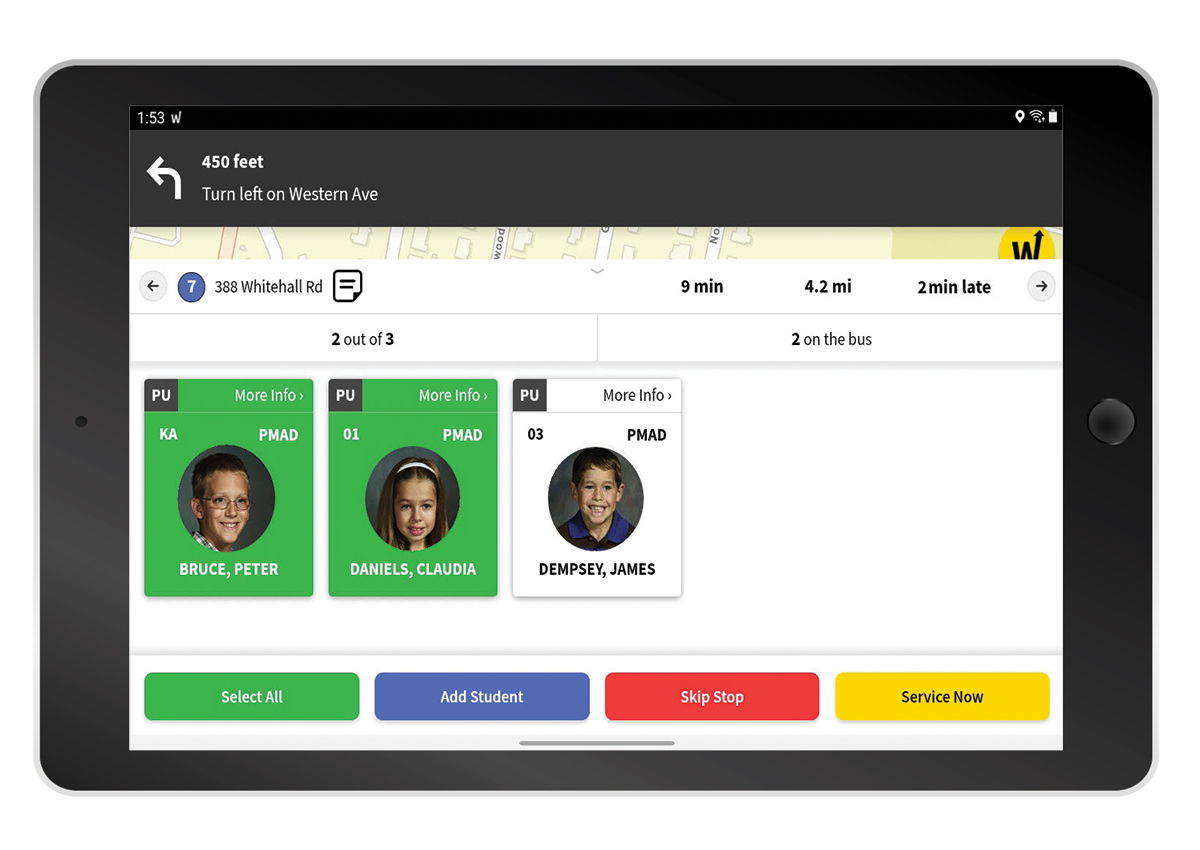
The future of smart school bus routing means better efficiencies, powered by Artificial Intelligence Optimization (AIO).
Transfinder has developed routing, scheduling, and fleet maintenance solutions since 1988, and the introduction of AIO is a game-changer for intelligent routing solutions, according to Transfinder President and CEO Antonio Civitella.
Transfinder recently included AIO in the latest iteration of its Routefinder PLUS software, and Civitella said the result is a faster, safer, and smarter routing solution.
“With AIO, we have created another level of routing optimization,” Civitella said. “We are giving our clients the ability to modify our software, to put in certain parameters that are unique to their districts.”
Districts can customize routing based on different travel scenarios: district-specific policies, time of day, turn restrictions, busy roads to avoid, weather, and other factors. With AIO, Routefinder PLUS becomes “smarter” as districts feed more data into the software.
“Many routing products provide a map, and districts simply set up their routes manually,” he said. “We feel that next-generation routing must go beyond that simple equation.”
“With Routefinder PLUS, local knowledge and information is incorporated into the system, and the algorithm makes suggestions and changes based on those local variables,” he continued.
 Combined with data derived from Wayfinder – Transfinder’s all-in-one in-vehicle app – Routefinder PLUS allows districts to make smarter decisions about bus transportation and derive more critical information about students.
Combined with data derived from Wayfinder – Transfinder’s all-in-one in-vehicle app – Routefinder PLUS allows districts to make smarter decisions about bus transportation and derive more critical information about students.
The Wayfinder mobile app allows districts to build routes, take attendance and navigate – simply driving a route and accurately capturing the path, stop locations, driving directions, and times.
“Our expectation is that Routefinder PLUS and Wayfinder present a sort of ‘A-ha! moment’ for our customers,” Civitella said. “It changes efficiencies in a major way. For example, you can take attendance and figure out how many kids are at a certain stop, or how many kids take a certain route each day – do you even need that stop location anymore, based on the data? That kind of discovery is such an important aspect of these solutions.”
AIO efficiencies in action
The transportation department at Valley Central School District in Orange County, New York, transports approximately 4,400 kids per day, between the main district, private schools, and special schools.
When Renee Marchant, transportation coordinator for the district, first came to the department in late 2018, she found numerous inefficiencies in the district’s routing.
“The routes initially felt like they weren’t backed by logic,” Marchant said. “We had 28 high school routes, 37 middle school routes, and 32 elementary school routes. Using Routefinder PLUS, I was able to see an overview of all the routes and how they might feed into one another. It allowed us to increase efficiency by reducing unnecessary routes.”
Valley Central School District currently utilizes Routefinder PLUS and Viewfinder, which allows districts to monitor the day-to-day operations of the transportation department from any computer. Marchant can access updates on students, trips, field trips, vehicles, and staff at any time using Viewfinder.
“Routefinder PLUS gives us a much better overview of all our routes combined, which we never had before,” she said. “I can open all the high school routes, for example, or view the routes individually. I can see the inefficiencies that had previously been there, and the system suggests corrections.”
She added that Viewfinder has been invaluable as a communication tool between the district and schools, parents, and transportation companies.
“We used to receive many calls from schools whenever a student needed to change routes, or had some change to their routine,” she said. “Now, I can add the students into Routefinder PLUS and all the schools have their own view of the routes and the kids. Through Viewfinder, the schools know exactly what routes their kids are on. They know exactly the timing so they can help parents themselves, as opposed to just having parents call me.”
Routefinder PLUS was also critical for Valley Central School District during COVID-19 complications, and for prepping the coming school year.
“Routefinder PLUS allows us to run more than one database at a time,” she said. “That really helped during COVID, when we had kids on a ‘half-on, half-off’ schedule. We were able to sort the kids into different databases, and then easily create separate routes for each day.”
“Right now, it’s helping us turn over into the new year – because we are already planning summer school as well as the 2022/23 school year,” she continued. “We are able to copy our database and create the next year’s database, earlier than we’ve ever done before.”
With continued input from school staff’s institutional knowledge and expertise, the system takes into account the uniqueness of a district’s region and as a result is able to provide more efficient and effective database and route optimization while making the most of all resources, Civitella explained.
“The system is gaining the artificial intelligence from our clients. They know the local area and situations that are specific to their district,” he said. “That kind of AIO is the engine that powers the automation.”
“Today we have technology that we have heavily invested in to make sure that there is a correlation of effort versus quality,” he continued. “Before districts could put as much effort as possible in but the quality just reached a certain ceiling. Now they can spend minimal time and get quality as a result. And that, to me, is the ultimate product and Transfinder’s secret sauce.”
Civitella also points out that within all that AIO, there are still certain district policies baked into the routing software to further ensure safe and effective optimization.
“For example, you don’t want kindergarten to third graders to cross the street to get to the bus,” he explained. “If you want to override that for whatever reason, the router has to override it intentionally. It has to be very intentional because, even for efficiency’s sake, without that human override, it won’t violate a policy.”
“So, despite all the automation, which is a wonderful thing, it also goes hand in glove with the policies that are baked in as well,” Civitella continued. “It still has that very necessary human connection.”


